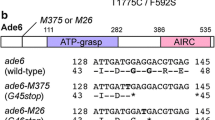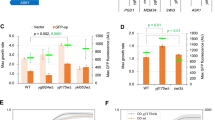Abstract
We previously conducted a search for genes whose overexpression causes nonsense suppression in Saccharomyces cerevisiae with a background of modified expression of Sup35 variants. In this study, we analyzed the influence of genes encoding asparagine-glutamine-rich transcriptional factors on this process. We demonstrated that the overexpression of ABF1, GLN3, FKH2, MCM1, MOT3, and REB1 affects nonsense suppression in S. cerevisiae. The data obtained highlight the interrelation between the fundamental processes of transcription and translation in the living cell.
Similar content being viewed by others
References
Alberti, S., Halfmann, R., King, O., et al., A systematic survey identifies prions and illuminates sequence features of prionogenic proteins, Cell, 2009, vol. 137, pp. 146–158.
Benn, C.L., Sun, T., Sadri-Vakili, G., et al., Huntingtin modulates transcription, occupies gene promoters in vivo, and binds directly to DNA in a polyglutamine-dependent manner, J. Neurosci., 2008, vol. 28, pp. 10720–10733.
Chernoff, Y.O., Newnam, G.P., Kumar, J., et al., Evidence for a ‘protein mutator’ in yeast: role of the hsp70-related chaperone Ssb in formation, stability and toxicity of the [psi] prion, Mol. Cell. Biol., 2012, vol. 19, pp. 8103–8112.
Chiti, F. and Dobson, C.M., Protein misfolding, functional amyloid, and human disease, Annu. Rev. Biochem., 2006, vol. 75, pp. 333–366.
Cong, S.Y., Pepers, B.A., Zhou, T.T., et al., Huntingtin with an expanded polyglutamine repeat affects the Jab1-p27(Kip1) pathway, Neurobiol. Dis., 2012, vol. 46, pp. 673–681.
Crow, E.T. and Li, L., Newly identified prions in budding yeast, and their possible functions, Semin. Cell Dev. Biol., 2011, vol. 22, pp. 452–459.
Dagkessamanskaya, A., Ter-Avanesyan, M., and Mager, W.H., Transcriptional regulation of SUP35 and SUP45 in Saccharomyces cerevisiae, Yeast, 1997, vol. 13, pp. 1265–1274.
Derkatch, I.L., Bradley, M.E., Zhou, P., et al., Genetic and environmental factors affecting the de novo appearance of the [PSI+] prion in Saccharomyces cerevisiae, Genetics, 1997, vol. 147, pp. 507–519.
Derkatch, I.L., Bradley, M.E., Hong, J.Y., and Liebman, S.W., Prions affect the appearance of other prions: the story of [PIN+], Cell, 2001, vol. 106, pp. 171–182.
Hanahan, D., DNA Cloning: a Practical Approach, IRL Press, 1985.
Harrison, P.M. and Gerstein, M., A method to assess compositional bias in biological sequences and its application to prion-like glutamine/asparagine-rich domains in eukaryotic proteomes, Genome Biol., 2003, vol. 4, p. 40.
Inge-Vechtomov, S.G. and Adrianova, V.M., Recessive supersuppressors in yeast, Russ. J. Genet., 1970, vol. 6, pp. 103–115.
Inge-Vechtomov, S.G., Tichodeev, O.N., and Karpova, T.S., Selective systems of obtaining of recessive ribosomal suppressors in yeast, Russ. J. Genet., 1988, vol. 24, pp. 1159–1165.
Kaiser, C., Michaelis, S., and Mitchell, A., Methods in Yeast Genetics, New York: Cold Spring Harbor Lab. Press, 1994.
Lee, T.I., Rinaldi, N.J., Robert, F., et al., Transcriptional regulatory networks in Saccharomyces cerevisiae, Science, 2002, vol. 298, pp. 799–804.
Nizhnikov, A.A., Magomedova, Z.M., Saifitdinova, A.F., et al., Identification of genes encoding potentially amyloidogenic proteins that take part in the regulation of nonsense suppression in yeast Saccharomyces cerevisiae, Russ. J. Genet.: Appl. Res., 2012a, vol. 2, pp. 399–405.
Nizhnikov, A.A., Magomedova, Z.M., Rubel, A.A., et al., [nsi+] determinant has a pleiotropic phenotypic manifestation that is modulated by SUP35, SUP45, and VTS1 genes, Curr. Genet., 2012b, vol. 58, pp. 35–47.
Ong, W., Ibrahim, M., Town, M., and Johnson, J., Functional differences among the six Saccharomyces cerevisiae tRNATrp genes, Yeast, 1997, vol. 13, pp. 1357–1362.
Ono, B., Yoshida, R., Kamiya, K., and Sugimoto, T., Suppression of termination mutations caused by defects of the NMD machinery in Saccharomyces cerevisiae, Genes Genet. Syst., 2005, vol. 80, pp. 311–316.
Osherovich, L.Z. and Weissman, J.S., Multiple Gln/Asnrich prion domains confer susceptibility to induction of the yeast [PSI+] prion, Cell, 2001, vol. 106, pp. 183–194.
Rogoza, T., Goginashvili, A., Rodionova, S., et al., Non-Mendelian determinant [ISP+] in yeast is a nuclearresiding prion form of the global transcriptional regulator Sfp1, Proc. Natl. Acad. Sci. USA, 2010, vol. 107, pp. 10573–10577.
Rubel, A.A., Saifitdinova, A.F., Lada, A.G., Nizhnikov, A.A., Inge-Vechtomov, S.G., and Galkin, A.P., Yeast chaperone Hsp104 controls gene expression at the posttranscriptional level, Molecular Biology., 2008, vol. 42, pp. 110–116.
Saifitdinova, A.F., Nizhnikov, A.A., Lada, A.G., et al., [NSI+]: a novel non-Mendelian suppressor determinant in Saccharomyces cerevisiae, Curr. Genet., 2010, vol. 56, pp. 467–478.
Sambrook, J., Fritsch, E.F., and Maniatis, T., Molecular Cloning: A Laboratory Manual, New York: Cold Spring Harbor Lab. Press, 1989.
Sherman, F., Fink, G.R., and Hancks, J.B., Methods in Yeast Genetics, New York: Cold Spring Harbor Lab. Press, 1986.
Stansfield, I., Jones, K.M., Kushnirov, V.V., et al., The products of the SUP45 (eRF1) and SUP35 genes interact to mediate translation termination in Saccharomyces cerevisiae, EMBO J., 1995, vol. 14, pp. 4365–4373.
Ter-Avanesyan, M.D., Dagkesamanskaya, A.R., Kushnirov, V.V., and Smirnov, V.N., The SUP35 omnipotent suppressor gene is involved in the maintenance of the non-Mendelian determinant [PSI+] in the yeast Saccharomyces cerevisiae, Genetics, 1994, vol. 137, pp. 671–676.
Weiss, W.A., Edelman, I., Culbertson, M.R., and Friedberg, E.C., Physiological levels of normal tRNA(CAGGln) can effect partial suppression of amber mutations in the yeast Saccharomyces cerevisiae, Proc. Natl. Acad. Sci. USA, 1987, vol. 84, pp. 8031–8034.
Wickner, R.B., [URE3] as an altered URE2 protein: evidence for a prion analog in Saccharomyces cerevisiae, Science, 1994, vol. 264, pp. 566–569.
Workman, C.T., Mac, H.C., and McCuine, S., A systems approach to mapping DNA damage response pathways, Science, 2006, vol. 19, pp. 1054–1059.
Zakharov, I.A., Kozhin, S.A., Kozhnina, T.N., and Fedorova, I.V., The Collection of Techniques in Yeast Genetics, Leningrad: Nauka, 1984.
Zhouravleva, G., Frolova, L., Le Goff, X., et al., Termination of translation in eukaryotes is governed by two interacting polypeptide chain release factors, eRF1 and eRF3, EMBO J., 1995, vol. 14, pp. 4065–4072.
Author information
Authors and Affiliations
Corresponding author
Additional information
Published in Russian in Ekologicheskaya Genetika, 2013, Vol. 11, No. 1, pp. 49–58.
The article was translated by the authors.
Rights and permissions
About this article
Cite this article
Nizhnikov, A.A., Kondrashkina, A.M., Antonets, K.S. et al. Overexpression of genes encoding asparagine-glutamine-rich transcriptional factors causes nonsense suppression in Saccharomyces cerevisiae . Russ J Genet Appl Res 4, 122–130 (2014). https://doi.org/10.1134/S2079059714020051
Received:
Accepted:
Published:
Issue Date:
DOI: https://doi.org/10.1134/S2079059714020051




